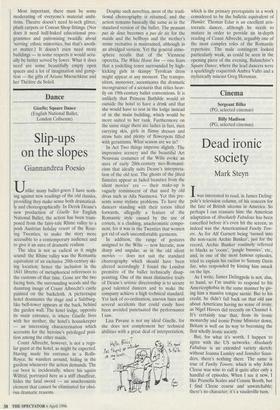Dance
Giselle; Square Dance (English National Ballet, London Coliseum)
Slip-ups on the slopes
Giannandrea Poesio
Unlike many ballet-goers I have noth- ing against new readings of the old classics, providing they make sense both dramatical- ly and choreographically. In Derek Deane's new production of Giselle for English National Ballet, the action has been trans- posed from the fairy-tale Rhine valley to a posh Austrian holiday resort of the Roar- ing Twenties, to make the story more accessible to a contemporary audience and to give it an aura of dramatic realism.
The idea is not as radical as it might sound: the Rhine valley was the Romantic equivalent of an exclusive 20th-century ski- ing location; hence the inclusion in the 1841 libretto of metaphorical references to the customs of that time. Gone are the two facing huts, the surrounding woods and the daunting image of Count Albrecht's castle painted on the backcloth. A picturesque hotel dominates the stage and a Salzburg- like bell-tower appears at the back, behind the garden wall. The hotel lodge, opposite its main entrance, is where Giselle lives with her mother, the hotel's housekeeper — an interesting characterisation which accounts for the heroine's privileged posi- tion among the other maids.
Count Albrecht, however, is not a regu- lar guest at the hotel, as might be expected. Having made his entrance in a Rolls- Royce, he wanders around, hiding in the gardens whenever the action demands. The car boot is, incidentally, where his squire Wilfrid, portrayed here as a stiff chauffeur, hides the fatal sword — an anachronistic element that cannot be eliminated for obvi- ous dramatic reasons. Despite such novelties, most of the tradi- tional choreography is retained, and the action remains basically the same as in the standard version of the ballet. The peasant pas de deux becomes a pas de six for the maids and the bellboys and the mother's mime recitative is maintained, although in an abridged version. Yet the general atmo- sphere recalls that of the Viennese operetta, The White Horse Inn — one fears that a yodelling tenor surrounded by high- kicking girls in skimpy Tyrolean dress might appear at any moment. The transpo- sition, moreover, accentuates the dramatic incongruence of a scenario that relies heav- ily on 19th-century ballet conventions. It is unlikely that Princess Bathilde would sit outside the hotel to have a drink and that she would have to rest in the lodge instead of in the main building, which would be more suited to her rank. Furthermore on the same stage there are ladies in furs, men carrying skis, girls in flimsy dresses and straw hats and plenty of flowerpots filled with geraniums. What season are we in?
In Act Two things improve slightly. The impressive scenery and the beautiful Art Nouveau costumes of the Wilis evoke an aura of early 20th-century neo-Romanti- cism that ideally suits Deane's interpreta- tion of the old text. The ghosts of the jilted fiancées appear as faded beauties from the silent movies' era — their make-up is vaguely reminiscent of that used by old divas such as Alla Nasimova. Yet this pre- sents some stylistic problems. To have the dancers standing with their torsos tilted forwards, allegedly a feature of the Romantic style caused by the use of corsets, is a clashing, anachronistic compo- nent, for it was in the Twenties that women got rid of such uncomfortable garments.
In addition, the range of gestures assigned to the Wilis — now hieratic, now sharp and angular, as in the old silent movies — does not suit the standard choreography which should have been altered accordingly. I found the London premiere of the ballet technically disap- pointing. One of the most distinctive traits of Deane's artistic directorship is to secure good talented dancers and to make the company achieve a high technical standard. Yet lack of co-ordination, uneven lines and several accidents that could easily have been avoided punctuated the performance I saw.
Lisa Pavane is not my ideal Giselle, for she does not complement her technical abilities with a great deal of interpretation, which is the primary prerequisite in a work considered to be the balletic equivalent of Hamlet. Thomas Edur is an excellent aris- tocratic dancer, although he needs to mature in order to provide an in-depth reading of Count Albrecht, arguably one of the most complex roles of the Romantic repertoire. The male contingent looked particularly weak, as could be seen in the opening piece of the evening, Balanchine's Square Dance, where the lead dancers were a sparklingly coquettish Ambra Vallo and a stylistically miscast Greg Horsman.


























































 Previous page
Previous page